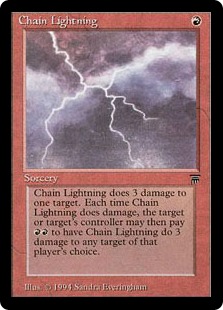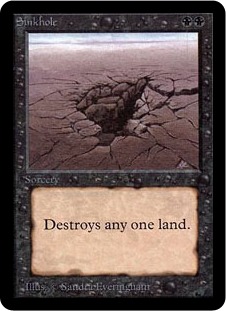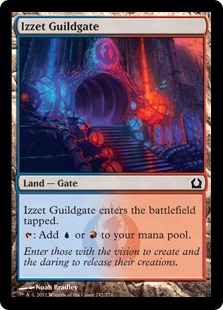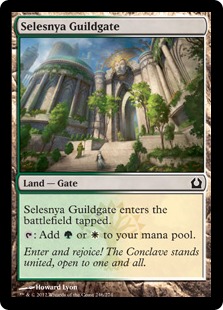
A cube is a collection of the most powerful and iconic cards of Magic's history, playing together as a cohesive limited environment. Pauper is a format of Magic where you're restricted to only commons; the nuts and bolts of magic, if you will. In cube you're pawing cards with Ancestral Recall; in Pauper you’re throwing around Think Twice.
So a Pauper cube would seem counter-intuitive, right?
Well, maybe. There's no doubt that if you want to play with planeswalkers and cards banned from Legacy, to immerse yourself in the most exciting chapters Magic history, normal cube might be the way to go. But Pauper's got its own things going for it.
1. It's cheap.
One of the draws to playing the most iconic cards in Magic history is, well, acquiring the most iconic cards in Magic history. Not to mention updating your cube with the cards from new sets. Even for those who want to play the most powerful version of the cube possible, getting Black Lotus or Ancestral Recall might just not be possible (although there's definitely merit in cutting out these cards for reasons other than cash.)
By comparison, Pauper cubes are much less expensive to start and maintain; maybe the most expensive card is Chain Lightning or Sinkhole. The average Pauper cube will cost about $100-$200 to start up, and at that point that's only marginally more than what the sleeves and box will cost you.


The closest Pauper comes to bling.
This has implications beyond just a low start-up investment, though. For one, bringing your cube to public places and drafting with strangers is much easier when the most expensive card you're playing with is a promo Sinkhole. The chance of theft is lower, as well as replacement costs, and overall your anxieties as the cube owner will be much less.
Pimping out your cube - that is, making it all pretty with foils, promos and alters - becomes cheaper too, and so you'll be able to start doing it sooner and making the cube a thing of beauty.
2. The cards are common (har har.)
What I mean by that is that, save one or two obscure cards from Portal Three Kingdoms or whatnot, the cards are easy to locate and acquire. If you've been playing for a while, and regularly attend drafts or prereleases at your LGS, you probably have boxes of unplayed, unwanted commons sitting in a corner. And chances are, a fair chunk of your future Pauper cube is lying in there. Riffle through your friends' collections too and you might just find you have a sweet 360 without having bought a single card.
This also brings us back to what I was saying earlier about new set releases and updates to your cube. This is how I get new cards for my cube: go to the prerelease with friends. Enjoy myself. After it, riffle through my friend's unwanted pools and pulling out multiples of what I need. It's really that simple. Pimping the cube is just as easy; often my LGS will have multiple unwanted foils of the commons from the previous set, so around the same time as I go to, say, Avacyn Restored prerelease, I can pick up foils of all the Dark Ascension commons I cube with cheaply and easily.
3. It's like Limited put to maximum volume.
Frankly this might be the entire definition of cube, but Pauper cube is the closest relative to Limited and its style of play. After all, it's the commons that define Limited environments. Games of Pauper are often made up of the same core elements as normal Limited games: removal spells, aggressive creatures, combat tricks, etc. Commons that have defined Limited formats in the past, recent examples including Brimstone Volley, Travel Preparations and Mist Raven, are all available again in one huge mass of awesome.
Because of all these things, Pauper cube is a great way of practising Limited. For me, who has literally played one booster draft outside of cube (Mirrodin Besieged or Scars, I don't remember, I just know I played GB Infect.), Pauper cube has taught me a lot: drafting the correct balance of creatures and spells, building a deck with an appropriate number of finishers and ways of winning, and sideboarding properly. Simply playing Pauper cube the amount that I do now has vastly improved my play.
Additionally, my card evaluation for Limited environments has improved vastly. I care about the commons of a set a hell of a lot more than the rares and uncommons that won’t have as great an impact on Limited, and as a cube designer, I'm constantly considering how strong cards are in the context of their Limited environment.
Regularly my playgroup and I will come together on Skype and discuss the new set's commons after they've all been spoiled. On MTG Salvation, the set reviews by our members and the various discussion threads facilitate the exchange of opinions about the worth of cards and let us improve on our abilities. And if you followed Limited after spoiler season, you learn about how cards performed compared with your initial evaluations of them. Finding out cards that shock everyone with their playability is very rewarding and educational for your card evaluation skills.
How To Get Started.
So what do you do if you want to start a Pauper cube? What do you have to think about?
1. Know what's common.
Wait, what?
A common is a common, right? There shouldn't be any room for debate here; a River Boa is just as common as it is green and a creature.
Well, not quite. Let's take a look at River Boa. It was first printed in Visions as a common, but then reprinted in Sixth Edition and later Zendikar as an uncommon. So is it eligible for Pauper cube?
What about Act of Treason? As an heir to the uncommon Threaten, Act of Treason was printed as an uncommon in Magic 2010 but then at common for the two core sets afterwards. If you make the argument that River Boa should be considered a common because it was printed as a common first, where does that leave Act of Treason?
Many people consider that, if it's been printed once at common, it's eligible for Pauper cube. It's a simple enough conclusion and one that makes a lot of sense, but not one you necessarily have to follow.
Another topic you'll have to consider is Masters Edition. Masters Editions are reprint sets released specifically for Magic Online, and sometimes they switch around the rarity of cards to play better in the new set’s Limited. Are cards that are common in Masters Edition but nowhere else, like Phantom Monster, truly "common"?
This is an interesting and divisive issue. For many, the fact that Masters Edition has never been physically printed means that they don't count. On the other hand, if the developers at Wizards decided it was common enough, then maybe that's good enough for Pauper.
What will it be?
A running theme in this list is that I'm trying not to affect your decision with my own preferences. We're not discussing whether Loxodon Warhammer or Jace, the Mind Sculptor are commons. These issues I bring up are not black and white and certainly do not have a universally correct answer; only one that's correct for you, based on your own ways of organising cards and goals. I don't consider these things worth arguing about. We’re talking about upwards of six or seven cards in the entire cube. The lines you draw are going to be arbitrary no matter what, but drawing them at all is still important.
2. Know your card pool’s restrictions.
Which connects to the previous point. Once you decide what's common and what's not, you need to think about other things that you won't be cubing with for one reason or another. Will you pay with the Unsets, like Unhinged? Will you play with Portal cards?
Each choice will define your card pool a little better. In your own experiences you'll perhaps find other biases and decisions about what to cube with and what to exclude, and each one will make your cube more yours.
Another consideration is what cards you have to cut because of money or power level. Luckily Pauper doesn't have that many, if any at all, broken cards that need to be cut for power level reasons or expensive cards that need to be cut because your wallet's not big enough. Like I said earlier, Sinkhole is the most expensive card in cube, followed by Chain Lightning, and your cube won't hurt that badly if you choose not to play them or wait a while to get them.
3. Know your cards.
No matter what kind of cube you're building, you need to know the cards you're working with. And in the case of Pauper cube, we're talking about 4700 unique common cards, which you couldn't even draw up in one Magiccards.info search.
Do you have to look through every single one? Probably. It's not a bad way to start your cube list by looking through every card and picking out cards. Your list will require polishing, but if you have any half-way good card evaluation skills at the outset, it'll be a strong starting point for further improvement.
But looking through all cards is not something you absolutely have to do at the beginning, and there are other ways of learning about the cards you cube with. Projects and resources have cropped up over at the Cube Forum over the years. For example, we've run two annual Pauper Power Ranking projects during 2010 and 2011, when we ranked the top 20 cards of each color and overall. These projects are filled with information and card evaluation help that can assist building your first cube.
When you become more familiar with cubing, and better versed in the card evaluation unique to Pauper cube, systematic reviews of all the commons ever becomes more effective, and maybe something you want to do repeatedly. Who knows, maybe that second or third time you look at red spells or black creatures will uncover a gem nobody has even considered yet.
4. Know your numbers.
How big will your cube be? How big with each section be?
Usually the bare minimum for a cube is 360 cards. That makes 24 boosters and is just enough for an 8-man draft. Even if you have a smaller playgroup, 360 means that you can draft with more people on special occasions and lets you cube with some great cards you'd have to cut otherwise.
Going larger, on the other hand, is certainly an option. Many people often choose to play 400 or 450 or more. It increases variance and means you don't see the same cards every single draft. If you're new to the cards in Pauper cube, you might want to start with a larger cube to get more experience with more cards before cutting down to a smaller size.
Larger cubes do have apparent weaknesses in the Pauper environment, though. The power level of cards drops fairly steeply after 400 or so; that's not to say that you'll be forced to play Squire and Angel's Mercy, but you'll definitely notice the difference in power level. For this reason, it's common to see people gradually cutting down their cubes to the magical 360.
Of course, if you start all the way from 400 cards, when will you experience the sweet, sweet pain of cutting down to 360 and watching the power level just soar?
Deciding how big your card sections, like lands or red cards, will also depend on and affect the overall size of your cube. Let’s take lands as an example. There are only so many playable land cycles at commons. When you’re trying to expand the cube beyond a certain threshold, about 500 or so cards, you’ll hit the ceiling of playable lands and won’t be able to keep expanding it to maintain the right proportion with the rest of the cube. Doing this can hurt your cube’s ability to support decks playing 3 or more colors. Thankfully, if Return to Ravnica and the Guildgates are any sign, over time the size of the land section will be able to grow with greater ease.


I get excited over the most innocuous things.
5. Know your archetypes.
A cube is not simply a pile of the best cards. It's a draft environment first and foremost, and it's your job as a cube designer to make it a fun one. How? Think about Innistrad Limited, or Rise of the Eldrazi Limited. They were considered some of the best draft formats in recent years because they promoted and forced you to draft decks, not just a bunch of good cards. The same goes for Pauper cube. You want to make the draft experience interesting and challenging; not simply snapping up cards based on a pick order than never changes no matter what deck you play.
You need to decide what decks you're supporting and cube with the cards that support them. Beside the big ones like Fliers and Aggro, what kind of niche archetypes do you want to support? Allies? Infect? Blue aggro? We’re talking 4700 cards here; there are definitely some interesting houses of cards you’ll be able to craft if you dare to go out exploring.
Some of the most fun archetypes to pop up in Pauper cube will come about purely by accident when you start playing your cube. I never thought that white and black could be any more than an awkward color combination to be in, but in a recent Team Draft, one of my friends built a sick midrange deck with removal, lifegain and recurring creatures. It blew us all away.
So the point is, you might not know exactly what kind of archetypes you most want to support until you start playing. Always keep that in mind – the best laid plans can fall to shambles for something much, much better.
6. Know your colors.
What does each color do? If you want to promote diversity of decks and play, each color can't just do one thing. They need to offer a number of different choices, cards that fit different roles and decks, and the right abundance of certain cards so that, say, the aggro deck can get enough cheap creatures to work properly, while the midrange and control decks have enough strong expensive finishers to steal the game. They need the right balance of removal and creatures, the right balance of cheap and expensive spells, the appropriate sideboard cards to even the match-up against certain decks.
All within the maybe 50 slots you allow for it.
Balancing these complex things and the tiny, intricate pieces of the whole is what you do as a cube designer. It's not easy, and not something you can get right on the very first go. It'll require a lot of playing with an imperfect cube to make it better, but once you get started, you’ll find your grasp on the colors and archetypes more refined, and your enthusiasm to getting better will simply sky-rocket.
7. Know your playgroup.
A cube does not exist in isolation and it certainly doesn't exist in your head alone. Your cube is made for drafting with your friends, and if your playgroup is much like mine, what you give them with the chance to play your cube will be repaid in the foils and foreign cards they come by on overseas trips, the time they spend looking through commons with as much care as you will, and hours on Skype or MTG Salvation discussing the new set and new card choices.
Eventually you might even start to find that your cube becomes as much theirs as it is yours. Because it's Pauper, the very legitimate concerns of theft or accountability for damaging cards aren't as annoying or come up as often (having a tight playgroup helps). So it becomes almost natural for this blurring of ownership lines to happen. For me, this was proven beyond doubt when, over the course of the school holidays, my cube actually switched hands within my playgroup something like two or three times, and I didn't mind at all (having a tight playgroup really helps).
What does this mean? It means listen to them. They'll have as much experience with your cube as you do, and you need to rely on them to collect information about cards that you don't get a chance to play with during a draft. You need to understand their own biases, and know that they might not have as much of a grasp on the overall view of the cube as you do, but also recognise the biases that you hold that they might help you break through.
Include them in discussion. Get their input on cards from the latest set you could play with and cards that should be cut. In all probability they will gladly pile their opinions and input on you. Even if you disagree with some of their opinions, remember: this cube is made to be played with, and if the people who are going to play it know what makes their experience more fun, you'll need some serious justification why you're ignoring them.
8. Join the community!
Are you disappointed that I couldn't finish it with another “Know …”?
I don't think I can even begin to describe how awesome the Cube Forum here on MTG Salvation is. It is a wealth of information for everything cube-related, including purchasing the right sleeves, pimping cards out, cases and boxes for your cube, and an endless array of card discussion and comparison that recedes into the horizon. A person could write a thousand articles about Cube and only scratch at the surface of what the Cube Forum itself has already covered and has to offer.
In the Cube Forum, the Pauper community is a relatively small but active community. Much of our day-to-day discussion happens in The Pauper Cube Thread, but we frequently host projects such as set reviews for new cards. The Third Annual Pauper Power Rankings, where we rank the best cards in Pauper Cube yet again, is also something to participate in..
As much of the material I research for this article I get from the brilliant cubists over there as comes from my own experiences. Need an opinion on your cube or a card that you've stumbled onto? You know where to go.
Winding Down.
There's a lot more to think about in Pauper cube than these basics. For one, there's the question of whether Pauper cube has too much removal and whether we should cut out powerful cards for a more fun Pauper environment. But these questions are complex beasts and not ones that you can easily and solely postulate and think your way out of – it all relies on playing the cube and getting more experience with the cards, the decks, the colors, the everything. And on that note, my last advice to you:
Just Play With The Damn Thing.
For all my rambling and theoretical gibberish, and for all the decisions on paper you'll be making to lay the foundations of your cube, it's a meaningless effort if you don't actually, you know, build and play it. Draft with your friends and create experiences. Learn to love the cards. Make the reasons to cube that I listed real and not simply words on a screen.
If you want to get better at card evaluation and build a stronger cube, the invaluable part of the learning curve will always be to play it. Your first and foremost priority should be the build a physical cube. Gather up a huge stack of sleeves (you may have to order them in bulk online), find whatever basics you've got lying around, get together with your friends and rummage through their collections to find the best commons you have. Maybe throw together a list with some help from the epic community and order the cards in bulk from your LGS.
Your cube might suck. Don't worry, mine did too when I started. That's when you look through card databases. That's when you come back and start reading articles, threads, discussions, arguments; join the vibrant Pauper community and make heard your own voice and opinions.
That's when the Magic happens.
Comments